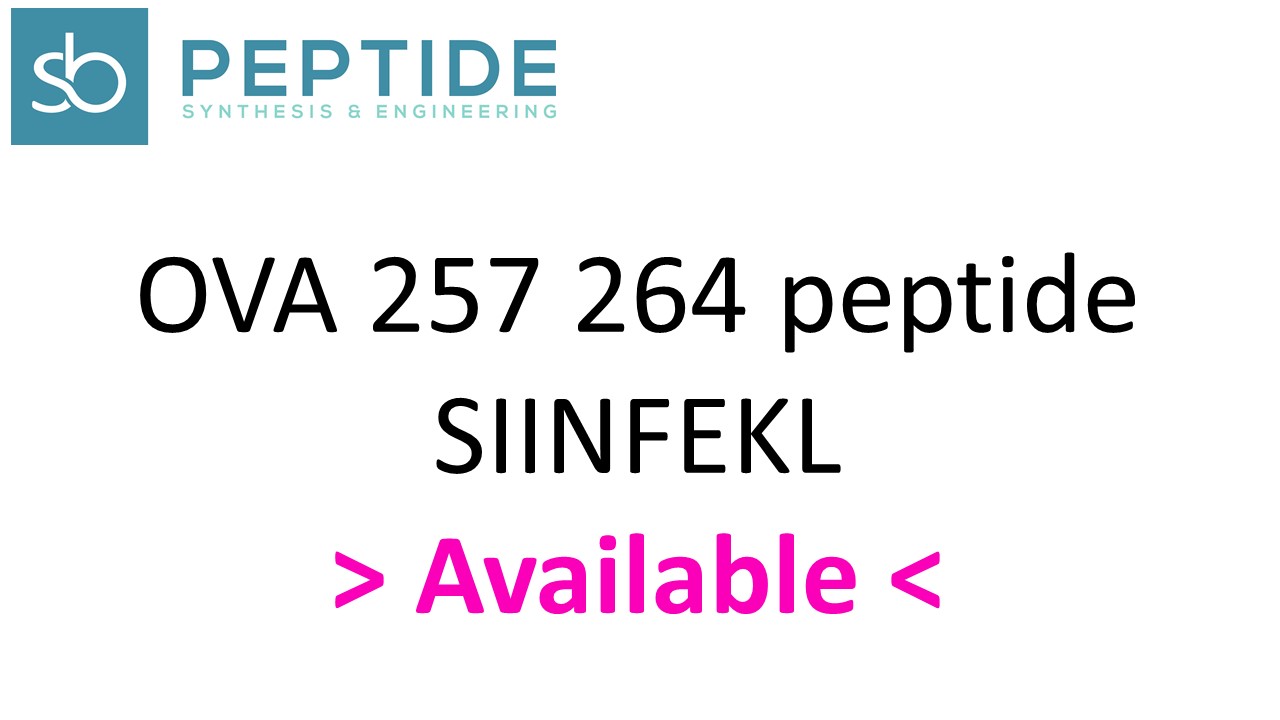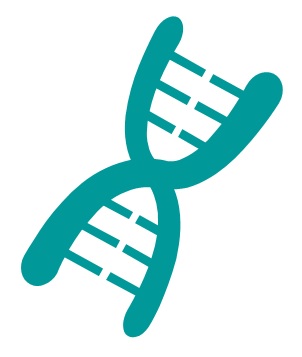OVA 257 264 peptide (SIINFEKL)– CAS: 138831-86-4
Ovalbumin protein
OVA 257-264 (H-2Kb) is an epitope of interest of the egg white albumen,ovalbumin. Ovalbumin is a glycoprotein that is sufficiently large and complex to be mildly immunogenic. Indeed,it has been demonstrated that Ovalbumin contains B-cell epitopes which are recognized by specific IgE antibodies and CD4 T cell epitopes restricted by the MHC I-Ad molecule in mice and by HLA-D molecule in human.
Applications of OVA 257-264
OVA 257-264 is used to stimulate T cells in PBMCs and to quantify peptide epitope specificity and IFN-γ releasing effector cells by ELISPOT assay. OVA 257-264 is also used to test new adjuvant in immunotherapeutic vaccine development. OVA 257-264 can form a stable hydrogel and stimulate a immune response. This reaction seems to be linked with OVA 257-264 property to self-assemble into a hydrogel.
SB-PEPTIDE offers the scrambled version of OVA 257-264 peptide (see section « OVA 257-264 scrambled« ) and OVA peptide pool.

Technical specification
 |
Sequence : SIINFEKL |
 |
MW : 963.16 Da (C45H74N10O13) |
 |
Purity : > 95% |
 |
Counter-Ion : TFA Salts (see option TFA removal) |
 |
Delivery format : Freeze dried in propylene 2mL microtubes |
 |
Other names : 1p1z,1p4l,HY-P1489,CAS: 138831-86-4 |
 |
Peptide Solubility Guideline |
 |
Bulk peptide quantities available – Carrier conjugation upon request Made in France – For research use only |
Price
| Product catalog | Size | Price € HT | Price $ USD |
| SB031-1MG | 1 mg | 77 | 96 |
| SB031-5MG | 5 mg | 270 | 337 |
| SB031-2*5MG | 2×5 mg | 385 | 481 |
| SB031-5*10MG | 5×10 mg | 737 | 921 |
SB-PEPTIDE offers a wide range of antigens on catalog. Browse our antigen catalog to find out more.
SB-PEPTIDE offers non-conformational epitope mapping service. SB-PEPTIDE can synthesize the antigenic protein as a library of overlapped peptides (usually 15aa,5aa overlap) and perform ELISA to determine the epitope.
References
Cell Metabolism. 2023 Apr 04;35(4):P633-650.e9. doi: https://doi.org/10.1016/j.cmet.2023.02.013
Linoleic acid potentiates CD8+ T cell metabolic fitness and antitumor immunity
The metabolic state represents a major hurdle for an effective adoptive T cell therapy (ACT). Indeed,specific lipids can harm CD8+ T cell (CTL) mitochondrial integrity,leading to defective antitumor responses. However,the extent to which lipids can affect the CTL functions and fate remains unexplored. Here,we show that linoleic acid (LA) is a major positive regulator of CTL activity by improving metabolic fitness,preventing exhaustion,and stimulating a memory-like phenotype with superior effector functions. We report that LA treatment enhances the formation of ER-mitochondria contacts (MERC),which in turn promotes calcium (Ca2+) signaling,mitochondrial energetics,and CTL effector functions. As a direct consequence,the antitumor potency of LA-instructed CD8 T cells is superior in vitro and in vivo. We thus propose LA treatment as an ACT potentiator in tumor therapy.
Sci Rep. 2019 Feb 25;9(1):2696. doi: https://doi.org/10.1038/s41598-019-39148-8
Ovalbumin Epitope SIINFEKL Self-Assembles into a Supramolecular Hydrogel
Here we show that the well-known ovalbumin epitope SIINFEKL that is routinely used to stimulate ovalbumin-specific T cells and to test new vaccine adjuvants can form a stable hydrogel. We investigate properties of this hydrogel by a range of spectroscopic and imaging techniques demonstrating that the hydrogel is stabilized by self-assembly of the peptide into nanofibres via stacking of β-sheets. As peptide hydrogels are known to stimulate an immune response as adjuvants,the immunoactive properties of the SIINFEKL peptide may also originate from its propensity to self-assemble into a hydrogel. This finding requires a re-evaluation of this epitope in adjuvant testing.
Methods Mol Biol. 2019;1988:109-122. doi: https://doi.org/10.1007%2F978-1-4939-9450-2_9
A SIINFEKL-Based System to Measure MHC Class I Antigen Presentation Efficiency and Kinetics
BACKGROUND:
Antigen presentation by classical MHC class I molecules to CD8+ T cells is a central aspect of the adaptive immune response. Here,we describe methods to monitor antigen presentation using the model ovalbumin Kb-binding peptide,SIINFEKL. SIINFEKL genetically incorporated into viral or cellular source proteins can be used to precisely probe various aspects of antigen presentation,including the kinetics of peptide generation,MHC class I surface stability,and presentation efficiency following pharmacological and genetic manipulations including genome wide and high throughput drug screening.
Infect Immun. 2018 Jun 21;86(7):e00281-18. doi: https://doi.org/10.1128/iai.00281-18
Brucella Peptide Cross-Reactive Major Histocompatibility Complex Class I Presentation Activates SIINFEKL-Specific T Cell Receptor-Expressing T Cells
Brucella spp. are intracellular pathogenic bacteria remarkable in their ability to escape immune surveillance and therefore inflict a state of chronic disease within the host. To enable further immune response studies,Brucella was engineered to express the well-characterized chicken ovalbumin (OVA). Surprisingly,we found that CD8 T cells bearing T cell receptors (TCR) nominally specific for the OVA peptide SIINFEKL (OT-1) reacted to parental Brucella-infected targets as well as OVA-expressing Brucella variants in cytotoxicity assays. Furthermore,splenocytes from Brucella-immunized mice produced gamma interferon (IFN-γ) and exhibited cytotoxicity in response to SIINFEKL-pulsed target cells.To determine if the SIINFEKL-reactive OT-1 TCR could be cross-reacting to Brucella peptides,we searched the Brucella proteome using an algorithm to generate a list of near-neighbor nonamer peptides that would bind to H2Kb Selecting five Brucella peptide candidates,along with controls,we verified that several of these peptides mimicked SIINFEKL,resulting in T cell activation through the « SIINFEKL-specific » TCR. Activation was dependent on peptide concentration as well as sequence. Our results underscore the complexity and ubiquity of cross-reactivity in T cell recognition. This cross-reactivity may enable microbes such as Brucella to escape immune surveillance by presenting peptides similar to those of the host and may also lead to the activation of autoreactive T cells.
Blood. 2006 Jul 15;108(2):544-50. doi: https://doi.org/10.1182/blood-2005-10-4015
Synergistic activation of dendritic cells by combined Toll-like receptor ligation induces superior CTL responses in vivo
Toll-like receptors (TLRs) are able to interact with pathogen-derived products and their signals induce the coordinated activation of innate and adaptive immune mechanisms. Dendritic cells (DCs) play a central role in these events. As the different TLRs are able to trigger MyD88/TRIF-dependent and -independent signaling pathways,we wondered if the simultaneous activation of these signaling cascades would synergize with respect to DC activation and induce superior cytotoxic T-lymphocyte (CTL) activity in vivo. We observed that indeed the combined activation of MyD88-dependent and -independent signaling induced by TLR7 and TLR3 ligands provoked a more rapid and more sustained bone marrow-derived DC (BMDC) activation with regard to the secretion of proinflammatory cytokines,like IL-6 and IL-12p70,and the expression of costimulatory molecules like CD40,CD70,and CD86. Furthermore,in the presence of combined TLR ligand-stimulated DCs,CD4(+) and CD8(+) T cells were insensitive toward the inhibitory effects of regulatory T cells. Most importantly,peptide-loaded BMDCs stimulated by TLR ligand combinations resulted in a marked increase of CTL effector functions in wild-type mice in vivo. Thus,our results provide evidence that unlocking the full potential of DCs by advanced activation protocols will boost their immunogenic potential and improve DC-based vaccination strategies.
